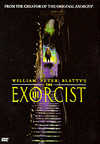The Exorcist III
Warner Home Video
Cast: George C. Scott, Ed Flanders
Extras: Theatrical Trailer
Rating:
During its theatrical run, audiences and critics alike were baffled by William Peter Blatty’s "The Exorcist III", but the film has a cult following, and now it can finally be viewed in a new <$PS,widescreen> transfer.
"The Exorcist III" is based on the novel "Legion" by William Peter Blatty, who also wrote the novel "The Exorcist", and is a true sequel to the first film, ignoring the events of "The Exorcist II: The Heretic." However, "The Exorcist III" takes the story in a totally different direction and tries very hard to distance itself from "The Exorcist." Incidentally, this is certainly the reason why so many people hated it. Most weren’t able to make heads-or-tails of the film. For proof, just read the back of the DVD box. The description there makes no sense at all and tells you nothing about the movie, showing that the marketers at Warner didn’t get the movie.
Kinderman is investigating a series of bizarre murders, which all appear to have been committed by the same killer. The murderer beheads his victims, and all of the victims have some sort of connection to the Catholic church. Kinderman is friends with Father Dyer (played by Ed Flanders; Reverend William O’Malley played Dyer in "The Exorcist"), a priest who also knew Father Karras. As Kinderman tries to solve the crimes, he turns to Father Dyer for help in sorting out the religious connection.
The pieces of the puzzle begin to fall into place as the murders seem to center on a hospital, and in particular, the psychiatric ward. There is a patient in isolation who bares an uncanny resemblance to Father Karras. And why are all of the elderly, catatonic patients suddenly becoming active? The story all comes together with a very unique revenge plot, with Kinderman fighting the ultimate evil in order to save the soul of an innocent man.
As someone who has never been a huge fan of "The Exorcist" (I’ve always thought that it was a little hokey), I didn’t expect much from "The Exorcist III." What I found was a film that isn’t afraid to take chances. For one thing, the film is dialogue driven. You don’t see that very often in modern horror films. Most of the dialogue, especially that of Kinderman, is lifted straight from the novel.
Probably the most noticeable aspect of "The Exorcist III" is Blatty’s style, as it relates to pacing, editing, and shooting. There are some gorgeous shots in the film, my favorite being the three helicopters flying over the church in Georgetown. Blatty has given the film a very odd pace, letting scenes go on for a long time and then smash-cutting on a line of shocking dialogue to the next scene. The best scene in the film involves a shot of a corridor in the hospital. The camera sits at one end of the hallway and we see a nurse and some policeman walking around. The shot goes on for a long time. It reaches the point of suspense, and then, when nothing happens, the viewer begins to wonder what is going on, and that’s when Blatty hits you with the shock. There are elements like this throughout the film. Blatty lets the film take its time and tells its story. And while this style may drive some people crazy, or make the film hard to follow for others, I found it to be very bold and refreshing. In this age of MTV style editing, it’s great to see a film that deliberately makes you wait.
One thing that people did talk about in concern to "The Exorcist III" was George C. Scott’s performance. Most felt that he was overacting or looked out of place in the film. He was even nominated for a Razzie Award. But, I feel that his emotional performance fits the quirky feel of the film. While he gives some impassioned speeches, he also does a great deal of subtle acting with his facial features. One of the fun things about "The Exorcist III" is spotting all of the cameos. In the film, you will see; former Georgetown coach John Thompson, Larry King, C. Everett Koop, Samuel L. Jackson (with an obviously dubbed voice!), Fabio (!), and NBA star Patrick Ewing as the angel of death.
The newly remastered <$DD,Dolby Digital> <$5.1,5.1 channel> soundtrack is somewhat of a disappointment. While the dialogue is always clear and audible, and the volume is well balanced, there is little surround sound action. The only time that the rear speakers show any activity is when the ominous growling (which represents the evil in the film) occurs and with some of the music. It’s obvious that someone put a lot of work into the sound design of the film (pay attention to how Patient X’s voice changes in pitch and tone), and it’s sad that the audio mix on the DVD didn’t fully represent this.
I’m sure that there are still plenty of people out there who hate "The Exorcist III" and can’t understand why it was released on DVD. Rest assured, the film has its defenders (obviously) and hopefully it can find a new audience to appreciate it with this new release. There is no question that this is the best that the film has ever looked. I just thank Warner Home Video for giving me the opportunity to possess this film.







